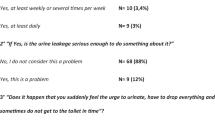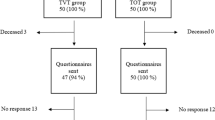Abstract
Introduction and hypothesis
To assess the outcome of the tension-free vaginal tape (TVT) procedure in female patients with urodynamic stress urinary incontinence at 17 years follow-up.
Methods
We carried out a prospective study at the 2nd Department of Obstetrics and Gynecology, Aretaieio Hospital, University of Athens, Greece. Patients who had undergone a TVT procedure 17 years ago. The follow-up assessment included gynecological examination, urinalysis, cough stress test in the lithotomy and/or upright position, filling and voiding cystometry, and uroflow. Also, all patients were required to complete the Patient Satisfaction Questionnaire (PSQ).
Results
Out of the 61 initial patients, 56 were available for follow-up. Objective cure rate was 83.9% (47/56) at 17 years follow-up. Subjective cure rate was 78.6% (44/56), subjective improvement was 8.9%, and failure rate was 12.5%. Frequency was present in 39.3% of patients, overactive bladder symptoms were present in 30.3% of patients and urge urinary incontinence was reported by 12.5% of patients. Difficulty emptying the bladder was reported by 10 patients (17.8%) and recurrent urinary tract infection was seen in 3.5% of patients. There was one case of TVT erosion to the vaginal mucosa, which was managed conservatively.
Conclusions
The TVT procedure for the management of stress urinary incontinence in women maintains its efficacy in the long term, having an objective cure rate of 83.9% and a subjective cure rate of 78.6% at 17 years’ follow-up, with a very low complications rate.
Similar content being viewed by others
References
Hunskaar S, Burgio K, Diokno A, Herzog AR, Hjalmas K, Lapitan MC. Epidemiology and natural history of urinary incontinence in women. Urology. 2003;62:16–23.
Minassian VA, Stewart WF, Wood GC. Urinary incontinence in women: variation in prevalence estimates and risk factors. Obstet Gynecol. 2008;111:324–31.
Ulmsten U, Petros P. Intravaginal slingplasty (IVS): an ambulatory surgical procedure for treatment of female urinary incontinence. Scand Nephrol. 1995;29:75–82.
Ulmsten U, Henriksson L, Johnson P, Varhos G. An ambulatory surgical procedure under local anesthesia for treatment of female urinary incontinence. Int Urogynecol J Pelvic Floor Dysfunct. 1996;7(2):81–5.
Liapis A, Bakas P, Creatsas G. Tension-free vaginal tape in the management of recurrent urodynamic stress incontinence after previous failed midurethral tape. Eur Urol. 2009;55(6):1450–5.
Gaddi A, Guaderrama N, Bassiouni N, Bebchuk J, Whitcomb EL. Repeat midurethral sling compared with urethral bulking for recurrent stress urinary incontinence. Obstet Gynecol. 2014;123(6):1207–12.
Oliveira R, Silva A, Pinto R, Silva J, Silva C, Guimaraes M, et al. Short term assessment of a tension free vaginal tape for treating female stress urinary incontinence. BJU Int. 2009;104(2):225–8.
Rizvi RM. Clinical and quality of life (QoL) outcomes in women treated by tension free vaginal tape (TVT). J Pak Med Assoc. 2009;59(5):274–7.
Delorme E. Transobturator urethral suspension: mini invasive procedure in the treatment of stress urinary incontinence in women. Prog Urol. 2001;11:1306–13.
De Leval J. Novel surgical technique for the treatment of female stress urinary incontinence: transobturator vaginal tape inside-out. Eur Urol. 2003;44:724–30.
Liapis A, Bakas P, Creatsas G. Long-term efficacy of tension-free vaginal tape in the management of stress urinary incontinence in women: efficacy at 5- and 7 year follow-up. Int Urogynecol J. 2008;19:1509–12.
Chêne G, Amblard J, Tardieu AS, Escalona JR, Viallon A, Fatton B, et al. Long-term results of tension-free vaginal tape (TVT) for the treatment of female urinary stress incontinence. Eur J Obstet Gynecol Reprod Biol. 2007;134(1):87–94.
Reich A, Kohorst F, Kreienberg R, Flock F. Long-term results of the tension-free vaginal tape procedure in an unselected group: a 7-year follow-up study. Urology. 2011;78(4):774–7.
Doo CK, Hong B, Chung BJ, Kim JY, Jung HC, Lee KS, et al. Five year outcomes of the tension free vaginal tape procedure for treatment of female stress urinary incontinence. Eur Urol. 2006;50:333–8.
Nilsson CG, Falconer C, Rezapour M. Seven year follow up of the tension free vaginal tape procedure for treatment of urinary incontinence. Obstet Gynecol. 2004;104:1259–62.
Νilsson CG, Palva K, Rezapour M, et al. Eleven years prospective follow-up of the tension free vaginal tape procedure for treatment of stress urinary incontinence. Int Urogynecol J Pelvic Floor Dysfunct. 2008;19:1043–7.
Ollson L, Abrahamsson AK, Kroon UB. Long-term efficacy of the tension-free vaginal tape procedure for the treatment of urinary incontinence: a retrospective follow up 11.5 years post-operatively. Int Urogynecol J Pelvic Floor Dysfunct. 2010;21:679–83.
Serati M, Ghezzi F, Cattoni E, Braga A, Siesto G, Torella M, et al. Tension-free vaginal tape for the treatment of urodynamic stress incontinence: efficacy and adverse effects at 10-year follow-up. Eur Urol. 2012;61:939–46.
Song PH, Kwon DH, Ko YH, Jung HC. The long-term outcomes of the tension-free vaginal tape procedure for treatment of female stress urinary incontinence: data from minimum 13 years of follow-up. Low Urin Tract Symptoms. 2017;9(1):10–4.
Serati M, Sorice P, Bogani G, Braga A, Cantaluppi S, Uccela S, et al. TVT for the treatment of urodynamic stress incontinence: efficacy and adverse effects at 13-year follow up. Neurourol Urodyn. 2017;36:192–7.
Νilsson CG, Palva K, Aarnio R, et al. Seventeen years follow up of the tension free vaginal tape procedure for female stress urinary incontinence. Int Urogynecol J. 2013;24:1265–9.
Braga A, Caccia G, Sorice P, Cantaluppi S, et al. Tension-free vaginal tape for treatment of pure urodynamic stress urinary incontinence: efficacy and adverse effects at 17-year follow-up. BJU Int. 2018;22(1):113-117.
Bump RC, Mattiasson A, Bo K, et al. The standardization of terminology of female pelvic organ prolapse and pelvic floor dysfunction. Am J Obstet Gynecol. 1996;75:10–7.
Papapetros PE, Ulmsten UI. An integral theory of female urinary incontinence. Experimental and clinical considerations. Acta Obstet Gynecol Scand. 1990;69:153–7.
Norton P, Brubaker L. Urinary incontinence in women. Lancet. 2006;367:57–67.
Rogers R. Urinary stress incontinence in women. N Engl J Med. 2008;358:1029–36.
Serati M, Salvatore S, Uccella S, Artibani W, Novara G, Cardozo L, et al. Surgical treatment for female stress urinary incontinence: what is the gold-standard procedure? Int Urogynecol J. 2009;20:619–21.
Lose G, Klarskov N. Retropubic versus transobturator MUS: time to revisit? Int Urogynecol J. 2017;28:1113–4.
Svenningsen R, Staff AC, Schiøtz HA, Western K, Kulseng-Hanssen S. Long term follow-up of the retropubic tension-free vaginal tape procedure. Int Urogynecol J. 2013;24:1271–8.
Lord HE, Taylor JD, Finn JC, Tsokos N, Jeffery JT, Atherton MJ, et al. A randomized controlled equivalence trial of short term complications and efficacy of tension-free vaginal tape and suprapubic urethral support sling for treating stress incontinence. BJU Int. 2006;98(2):367–76.
Author information
Authors and Affiliations
Corresponding author
Ethics declarations
Conflicts of interest
None.
Rights and permissions
About this article
Cite this article
Bakas, P., Papadakis, E., Karachalios, C. et al. Assessment of the long-term outcome of TVT procedure for stress urinary incontinence in a female population: results at 17 years’ follow-up. Int Urogynecol J 30, 265–269 (2019). https://doi.org/10.1007/s00192-018-3713-4
Received:
Accepted:
Published:
Issue Date:
DOI: https://doi.org/10.1007/s00192-018-3713-4




